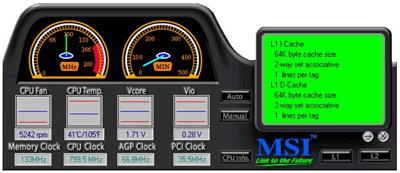MSI K7T Turbo Socket-A KT133A ATX
by Mike Andrawes on January 30, 2001 1:49 AM EST- Posted in
- Motherboards
Stability and RAID
The K7T Pro2 was probably most famous for its supreme stability and, of course, there is no way MSI is going to let that slip with the K7T Turbo. Beside the careful motherboard design that MSI has been using since the early K7T Pro days, MSI puts in four 4700uF and two 3900uF capacitors to make sure all the signals are clean.
The result? MSI is still the king of stability. Once again, during our 24-hour stress tests, the K7T Turbo system did not crash once. Compared to the two crashes by the ABIT and EPoX boards, the K7T Turbo definitely earns some points here. Since we didn’t encountered any crashes at all for 24 hours, we decided to run the stability tests even longer on the K7T Turbo to see how long it would take the board to fail. Surprisingly, after running the system non-stop for more than 48 hours, we still did not encounter a single crash.

MSI is one of the few manufacturers to use 4700uF capacitors
Since RAID is becoming more common these days, MSI also decided to add in an on-board IDE RAID controller. MSI chose the Promise PDC20265R Ultra ATA 100 IDE RAID controller, providing two IDE channels and support for up to four ATA 100 devices. Together with the two on-board IDE controllers by the VIA 686B South Bridge, the board is capable of supporting eight Ultra ATA 100 IDE devices, which should be enough for most users. However, notice that the Promise RAID controller only supports RAID 0 (stripping) or RAID 1 (mirroring) configurations. Interestingly, RAID 0+1 is not supported,.

The Promise RAID controller supports the RAID 0 and RAID 1 configurations.

The two IDE connectors supported by the Promise controller.
In order to aid users in troubleshooting their system, MSI again includes their famous D-LED technology. It is a set of 4 LEDs seated between the serial / parallel ports and the sound / game ports. During boot up, as different components are initialized, the LEDs will change color from green to red. If the boot up is successful, all the LEDs will turn green, otherwise you can refer to the manual for the possible error code.
As usual, MSI includes their Fuzzy Logic III and Live BIOS utilities with the K7T Turbo. Fuzzy Logic III is software that allows you to do all your FSB overclocking inside the Windows environment, which should be very useful for beginners. Live BIOS allows you to download and update your BIOS under a Windows environment as well. Even though it does not support environments other than Windows for now, it is a good trend since Microsoft has started to phase out the DOS command prompt completely in Windows 2000 and Windows ME, which is essential for current BIOS update.
Since our board is just a pre-production sample, no manual was included. But from our experience with previous MSI products, the manual should contain detailed information on all the jumpers and settings. They usually lack details on how to install the motherboard, which is essential for new users. MSI also includes very detailed information on all the BIOS settings, so users can tweak the BIOS accordingly. All the drivers and utilities are included in the CD, so users should not have any problems in getting the motherboard to work.











0 Comments
View All Comments